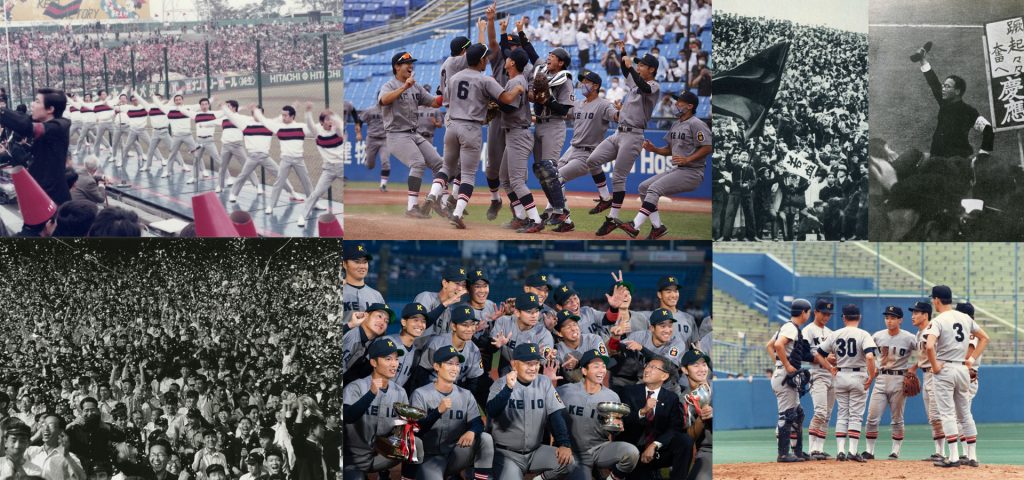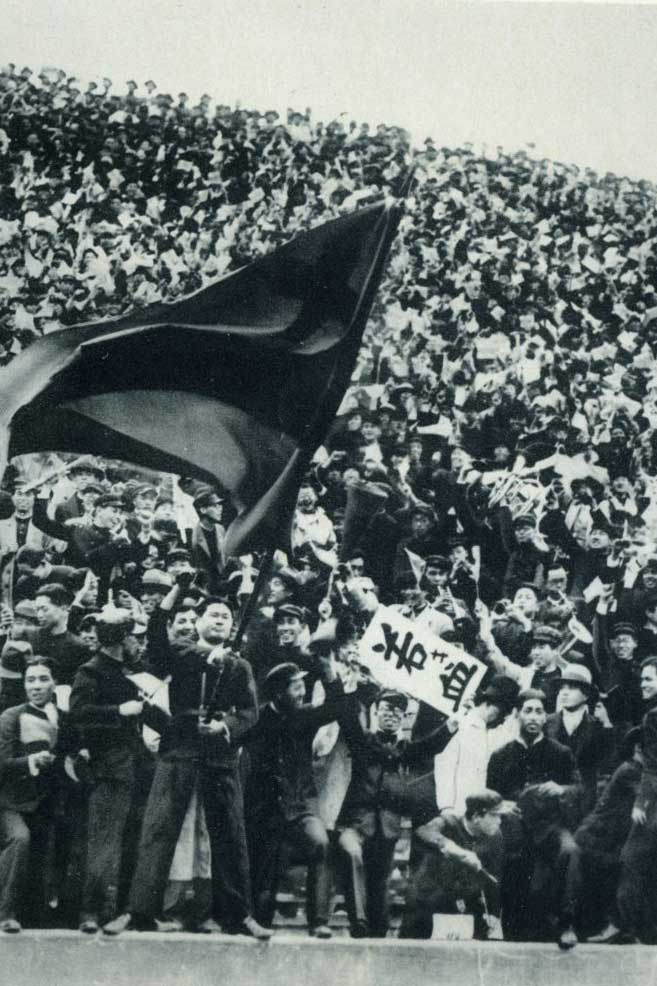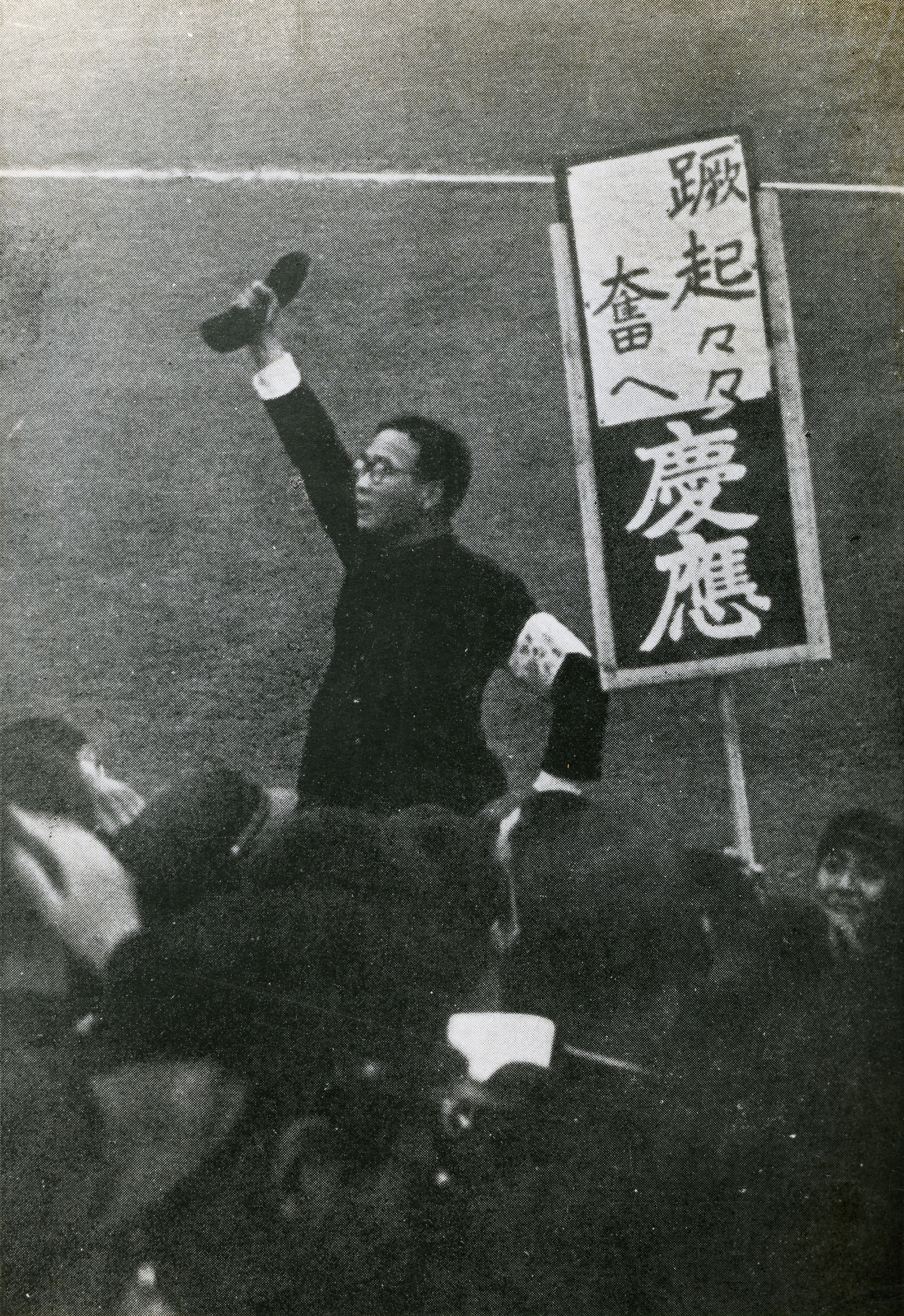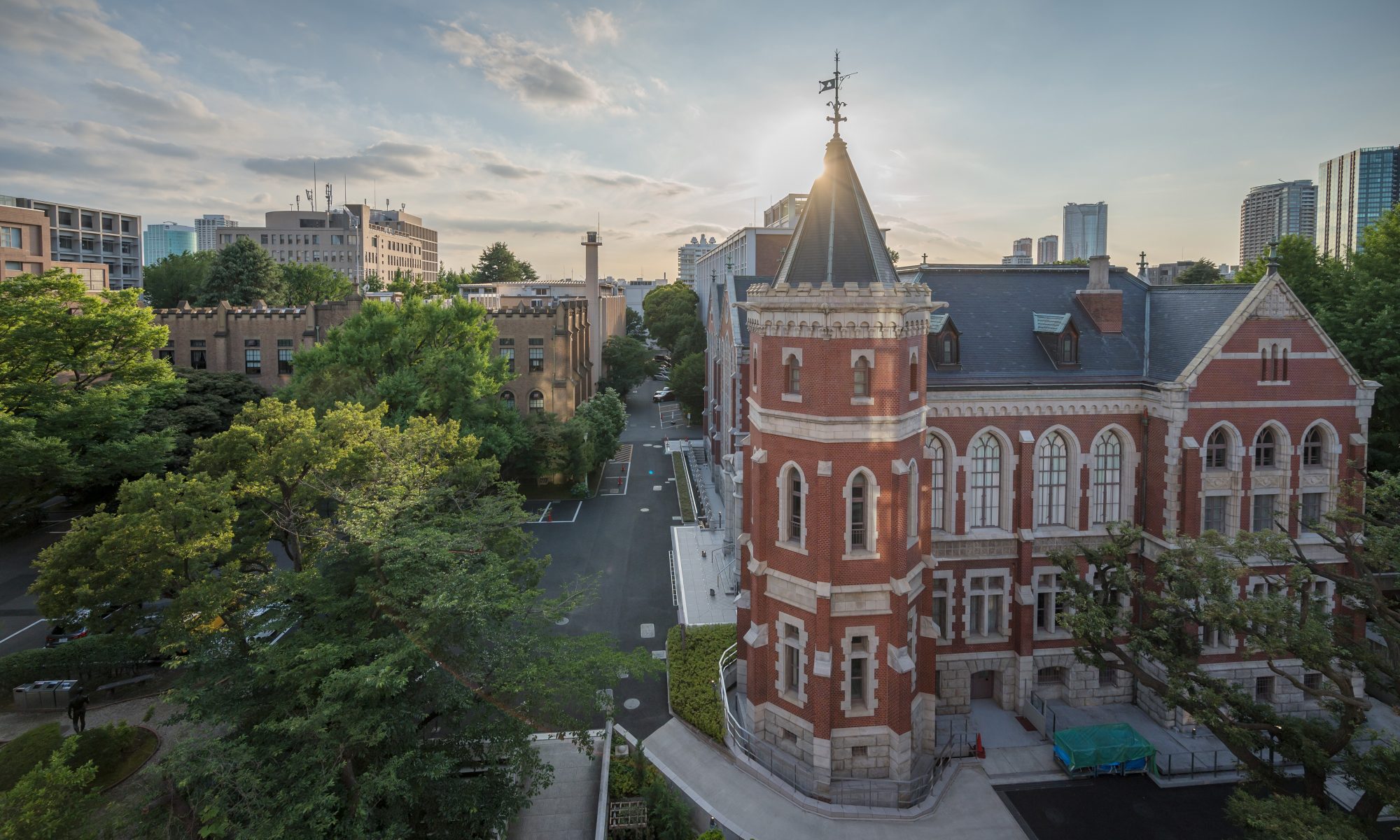
Keio University Insider Guide
(beta version)
The Waseda-Keio Baseball Games
In this guide we aim to offer concise explanations for new Japanese and international students so that they can better enjoy the Waseda-Keio Baseball Games. However, don’t be deterred if you’re already an expert—we also dive deeper in sections labeled Facts for Superfans. Be sure to check back as we update the guide regularly.
Tokyo Big6 Baseball League 101
- Six universities (Meiji, Waseda, Keio, Rikkyo, Hosei, and Tokyo University) compete in a round-robin tournament.
- The Big6 is held twice a year, in the spring and the fall. Games are mostly held on weekends.
- Teams face off in consecutive games until either team wins two games in a row, earning them one point. If neither team emerges victorious over the weekend of their match, or if games are delayed due to bad weather, the games carry on to Monday and subsequent days.
- The team with the most points at the end of the round-robin is declared the winner of the tournament. If there is a tie, the team with the greatest percentage of wins takes the crown.
- The winning team is awarded the Emperor’s Cup. In Japanese athletics, only one Emperor’s Cup is awarded per sport. For baseball, historical precedence has led to the award being reserved for the victor of the Tokyo Big6 Baseball League.
- All games take place at the Jingu Stadium. The stadium was built in 1926 to host student baseball games.


Facts for Superfans
- The first match of the tournament pits the victor of the previous league against the lowest ranked team.
- No Big6 matches are held on Thursdays or Fridays because those days are reserved for Tohto University Baseball League matches.
- The are no called games, and the number of extra innings is determined by the number of games played that day and whether the stadium is scheduled to be used for a professional baseball game.
- The league champion team goes on to represent Tokyo Big6 in other tournaments; the winner in the spring automatically qualifies for the All-Japan University Baseball Championship Series, and the winner in the fall automatically qualify for the Meiji Jingu Baseball Tournament.

The Waseda-Keio Baseball Games 101
- The match between Keio University and Waseda University is called sō-kei sen (Waseda-Keio Baseball Games) in Japanese. Sō stands for Waseda, taken from the first Japanese character of the university’s name, while kei represents Keio. Today, the term sō-kei sen has also come to mean a battle between the two most formidable entities in any given scenario.
- Some people affiliated with Keio refer to the games as the kei-so sen, intentionally flipping the order to place Keio first. However, others find this off-putting, favoring the more commonly-used sō-kei sen.
- The two teams are fierce rivals, and an equal or sometimes greater emphasis is placed on winning the Waseda-Keio matchup games than the overall championship.
- Team dugout placement in the Big6 follows the standard from professional baseball, with the first team to bat taking the space by the third base, and the second team to bat taking the space by the first base. However, for the sō-kei sen, Waseda always takes the first base side, and Keio takes the third base side. This exception stems from the so-called “Apple Incident” of 1933, when a food fight involving a half-eaten apple thrown from the Waseda-side cheering section at the Keio third basemen (who threw it back) led to an all-out riot.

Facts for Superfans
- The Big6 always ends with the Waseda-Keio Baseball Games because of the tournament’s historical roots in the rivalry between the two universities.
- Only first-period classes are held at Keio University on days that Waseda and Keio play each other to encourage students to go and watch the games. This rule was suspended during the pandemic but revived in the 2023 spring tournament.
Keio Cheer Group 101
- Seats are available for 500 yen to students with ID who want to sit in the cheering section.
- Members of cheering groups (in Japanese: ōen-dan) don traditional school uniforms and lead the cheering section in synchronized chants to support the team together. This is arguably the most exciting aspect of attending a Big6 game at Jingu Stadium.
- Each university has a different way of referring to their official cheering group. Meiji, Hosei, and Rikkyo use the Japanese term ōen-dan, while Waseda and Tokyo University call it ōen-bu.
- The full Japanese title for the Keio Cheer Group is ōen shidō bu (lit. “those who lead others in cheering). This phrasing implies that everyone who sits in the cheering section is part of the ōen-dan, not only the members of the official Keio Cheer Group who lead them in supporting the team.
- Each university has its own unique traditions regarding their school cheer uniforms and the ways they support their teams.
- At Keio, students don’t embellish or decorate their uniforms, preferring to keep them simple yet stylish.
- The men’s uniform for other universities includes wide-leg trousers called a bontan or dokan, paired with a cropped uniform jacket called a tanran. They also sometimes wear traditional geta sandals or hakama (a pant-like garment worn over a kimono). These unconventional and sometimes messy outfits, paired with the groups’ outlandish chanting styles, are a staple of Japanese cheering culture referred to as bankara.
- For a long time, women were barred from joining cheering squads. Keio was the first to break this tradition during the legendary “6-day battle” between Waseda and Keio in 1960, when Takayama Aiko, a baton twirler and student at Keio Girls Senior High School, made her debut as a cheerleader.
- The flag bearers for each cheering squad wear the traditional hats of their school.
- The hats of other universities were adapted from academic caps, which are square when viewed from above. Waseda’s hat is closest to a perfect square.
- Unlike other universities, Keio’s hat is round. Round hats were generally worn by high school or younger students, while square hats were the norm for university students. At Keio, however, the square design did not catch on as it was disliked for its formal and authoritative connotations.

Facts for Superfans
- In 1950, Keio’s cheer group began wearing white sweaters that featured blue and red stripes, the university’s colors. This caused an uproar among other universities as the design was thought to tarnish the sanctity of the cheering traditions of the time. Members of the cheer group can still be spotted sporting the striped sweater to this day.
- Student managers on the bench also wear student uniforms (blazers for Meiji, Hosei, and Rikkyo). Waseda University student managers even wear their square caps while on the bench.
- Naturally, as rivals, Waseda and Keio make fun of each other’s hat designs. Since Waseda’s hats are particularly square, they’re called “zabuton (square cushion) hats”, and Keio’s round and fluffy hats are called “anpan (red bean paste bun) hats”.
Cheering and Chants 101
- Teams on both sides exchange pre-prepared chants to encourage players at three points during the game: before its start, during the 7th inning, and after the match ends.
- While the cheer group delivers a chant, the audience is expected to stand up, take off their hats, and remain quiet.
- When the opposing team’s cheer group performs the “Furefure Keio” chant, Keio supporters respond with applause.
- Keio sings the Juku-ka (the Keio Alma Mater) and flies the Keio School Flag before and after the game. The “Furefure Keio” and the corresponding chant for the opposing team are performed at this time as well.
- During the 7th inning, Keio cheers by singing their fight song, Wakaki-chi (lit. “young blood”). This version of Wakaki-chi is sung at a slower tempo than its original arrangement as everyone waves their right arms up and down. When the song starts, the cheer conductor shouts “genki yoku, migi-te wo takaku, wakaki-chi!” (lit. “Raise your spirits and your right arms high, young blood!).
- During the chant, the cheer conductor will also raise their voice and yell “sora!” or “hai!”.

Facts for Superfans
- All four universities excluding Keio and Tokyo University sing their school songs during the 7th inning, as well as before and after the game. Tokyo University doesn’t have a school song, so they sing their sports song Tada Hitotsu (lit. “only one”) before and after match, and their fight song Ōzora To (lit. “with the big blue sky”) during the 7th inning.
- Originally the Juku-ka was sung selectively, only when exchanging chants during the Waseda-Keio Baseball Games, with Wakaki-chi being sung during matches with the other four universities. However, this drew criticism from the excluded four, causing Keio to shift to its current chant configuration in 1956.
- The pre-game chant is led by the first team to bat. The post-game chant is led by the winning team’s university. In the event of a tie, both teams chant at the same time, and both school songs are performed simultaneously.
- In pre-WWII Japan, heightened tensions among fans once spilled over into a huge brawl immediately following a Big6 game. It is said that chants were implemented to temper agitated spectators. The exchange of chants begins seamlessly at the end of a match before fans can become swept up in the joy of a victory or the sorrow of a loss.
- Keio used to chant the British “Hip Hip Hooray”. However, the use of English was criticized during the war, so supporters instead spelled the phrase using Chinese and Japanese characters (written “蹶起蹶起奮え” and read “kekki kekki furue”).

The School Flag
- In the cheering sessions before and after each game, both teams fly their school flags.
- The school flags are treated like sacred objects. The way the flag bearers wave the huge flags is spectacle for viewers to enjoy.
- There are many variations to the Keio School Flag, ranging from large and heavy flags that are only flown once every few years, to small flags that anyone could carry with ease. Each of these flags have their own name.
- Each also has its own specific kōjō, which is a verbal descriptor used to introduce the flag and its rank.
- The Gold Pen Mark Flag, as its name suggests, depicts the pen mark symbol of Keio University in gold. This is a special flag that is only flown during a match to determine the championship played between Waseda and Keio.
- During chants before and after each game, the leader of the team bows three times, and with that the flag also “bows” by being brought lower than its original position. This custom is called kirei (lit. “bowing of the flag”). The flag bearer’s training it tested here, since holding a heavy flag in a low position requires a great deal of strength and a specific posture.
Facts for Superfans
- The flag bearer’s belt has shoulder straps that cross along their back in a way similar to the way the pens do in the Keio Pen Mark symbol.
- The kirei (bowing of the school flag) custom is also observed during when the national anthem is sung at the opening and closing ceremonies. This is the most physically-taxing moment for the flag bearers, as they must hold the flag in a very uncomfortable position due to poor leverage for an extended period of time.
Image courtesy of Keio University Baseball Club
